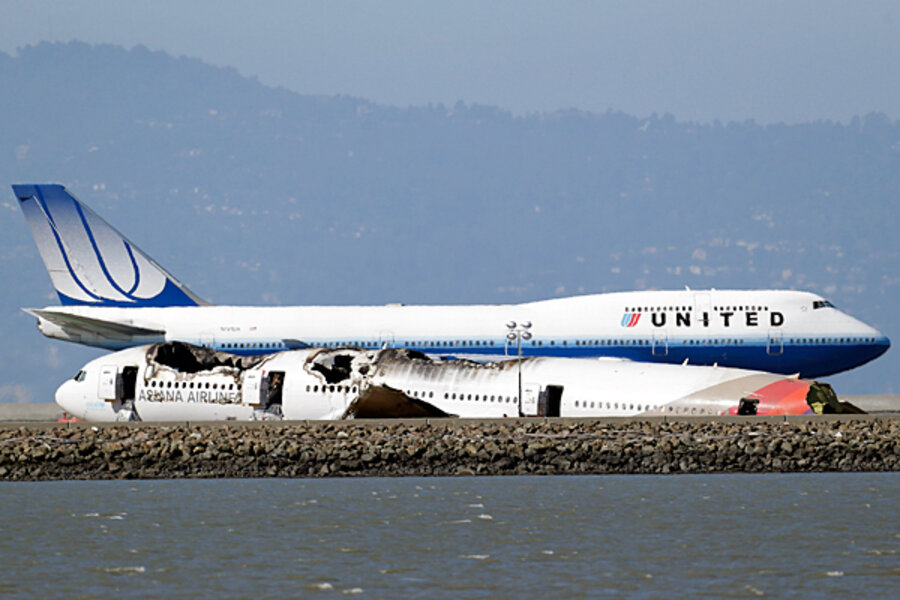Asiana crash: Improved technology, standards, and training likely saved lives
Loading...
Seconds before Asiana Airlines Flight 214 hit the sea wall at San Francisco Airport Saturday, flight attendant Lee Yoon-hye said she felt something was wrong. But after the crash, her training instincts kicked in as she searched the cabin and helped passengers exit – a reaction that, coupled with advances in technology and improved safety standards, likely contributed to the fact that there were far fewer fatalities than would have most likely occurred in the past, analysts say.
“Crashes are definitely more survivable today than they were a few decades ago,” Kevin Hiatt, president and chief executive of the Flight Safety Foundation, a nonprofit group in Alexandria, Va. aimed at improving air safety, told The Washington Post. “We’ve learned from the past incidents about what can be improved.”
Nearly all passengers and crew survived the Asiana crash – 305 of the 307 people onboard – and more than a third were able to leave without hospitalization. The San Francisco coroner is investigating whether one of the two Chinese teenagers who died Saturday was run over by an emergency response vehicle.
The statistics aren’t a rarity in the world of recent plane crashes. As The Wall Street Journal notes, “Everyone survived a 2008 Continental Airlines flight that veered off a Denver runway in high winds, splitting the body of the jet in two. Two passengers died in August 2010 when an Aires Boeing 737 landed short in bad weather at a Caribbean island, also splitting the passenger cabin into pieces. In April, a newly delivered Lion Air Boeing 737 crashed in poor visibility short of a runway in Bali, Indonesia; all 108 people aboard survived.”
Analysts say the result is due to, in part, better technology and safety standards, as well as improved crew training.
In the late 1980s, regulators required that all new passenger planes have seats able to withstand impacts that thrust them forward at 16 times the force of gravity. In 2005 the Federal Aviation Administration ordered the standard be applied to almost all passenger planes by October 2009. A Boeing spokesman told The Wall Street Journal that the company has been delivering all its jets with 16-G-rated seats since 2009.
“Before the advent of such stronger seats,” Mr. Hiatt told The Wall Street Journal, the intense vertical and horizontal force generated by a crash like Saturday's "would have caused many more seats to break free and pancake into each other, probably blocking exit paths."
Other technological advances included better materials for the fuselage, Todd Curtis, a former safety engineer with Boeing and now a director of the Airsafe.com Foundation, told The Washington Post. "It may have been worse if that fuselage had been designed with practices that were common 20 or 30 years prior."
Another key factor is better crew training to get passengers off a plane before it burns, said John Hansman, an aerospace professor at the Massachusetts Institute of Technology and director of the International Center for Air Transportation.
Mr. Hansman told USA Today that a crucial safety requirement is that airlines must certify they can get passengers off a plane within 90 seconds in an emergency, even if half the doors and escape slides are blocked. But getting people to leave their luggage and laptops can be a problem, Hansman said.
"If people had dawdled getting off this airplane, that would have put them at increased risk," Hansman said.
The use of better fire-resistant materials on seats and other parts of the cabin also contribute to fires burning with less intensity at first, allowing crucial time for evacuation, according to Hiatt of the Flight Safety Foundation.
Two fatal aircraft fires in the 1980s spurred the aviation industry to set stricter standards, Bill Waldock, a professor of safety science at Embry-Riddle Aeronautical University’s Prescott, Ariz. campus, told The Washington Post.
In 1983, an Air Canada flight made a safe emergency landing at the Cincinnati airport, but half of the 46 passengers and crew members died when they couldn’t escape the smoke and fire quickly. In 1985, a similar incident occurred after a British Airtours aborted takeoff in Manchester, England.
“Those two accidents together were the two-by-four to the head” that led the US and British governments to impose new fire-safety standards, said Mr. Waldock.
Ms. Lee, the flight attendant on Saturday’s flight, said at a press conference at the San Francisco airport that once the crash ended, “I wasn’t really thinking, but my body started carrying out the steps needed for an evacuation.”
“I was only thinking about rescuing the next passenger,” she said.
Investigators are still trying to determine what caused the Boeing 777 to crash on the runway after a last-second attempt to abort the landing, and what role the pilot’s inexperience with the type of aircraft may have played.
The two fatalities from Saturday’s crash were both Chinese teenage girls. Of the 182 injured people taken to hospitals, six remained in critical condition late Sunday, according to CBS. The remaining 133 had minor to moderate injuries, while many of the other passengers or crew members had more minor injuries that didn't require extra treatment.
Material from The Associated Press was used in this report.






